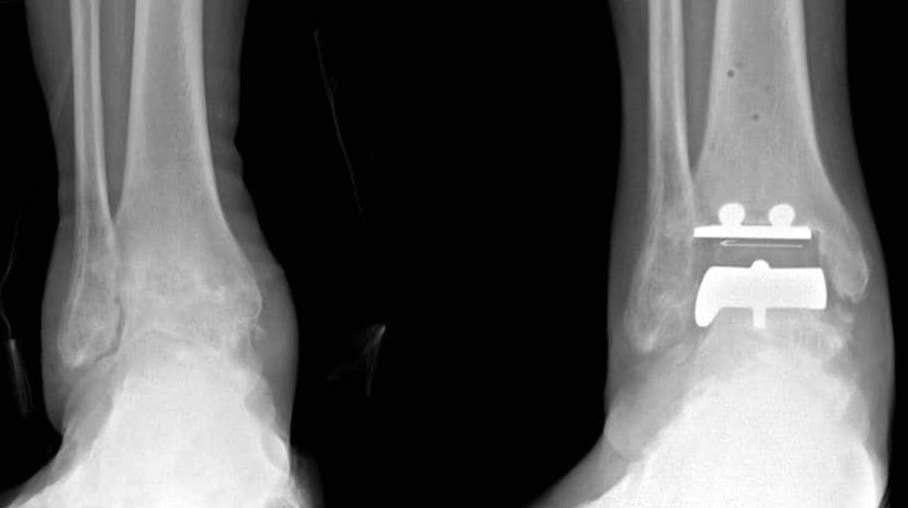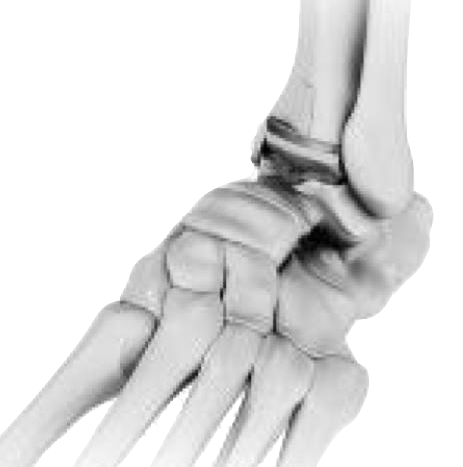Ankle Joint Replacement
What is an Ankle Joint Replacement?
Ankle joint replacement, also known as Total Ankle Arthroplasty, is a surgical procedure performed to relieve pain and immobility due to ankle arthritis.
Ankle joint replacement ensures the minimal destruction of the bones and preservation of the other joints of the foot from arthritis.
It also facilitates improved joint motion. However, wear-and-tear of the prosthesis is a major concern with joint replacement, especially in younger patients.
Treatment for Ankle Joint Arthritis
Arthritis is a chronic disease that leads to severe pain, swelling and disability.
Conservative treatment of ankle arthritis involves oral medications, bracing, physical therapy, modification of activity and joint injections. Ankle arthritis can also be treated by:
- Arthrodesis - fusing the tibia (shinbone) and talus (foot bone). Although the operation provides pain relief, it eliminates the movement of the ankle.
- Ankle Joint Replacement - as below
Why Consider an Ankle Joint Replacement?
Ankle arthritis can be treated with ankle joint replacement surgery, where the diseased joint ends are replaced with metal and plastic prostheses. The causes of ankle arthritis can include:
- Osteoarthritis
- Inflammatory Arthritis such as Rheumatoid Arthritis
- Infection
- Arthritis after fracture
Indications for Ankle Joint Replacement?
Ankle joint replacement is indicated with the following:
- When conservative treatments fail to reduce the pain and joint function
- Recommended for elderly patients with a low functional demand
- Rheumatoid arthritis
However, the procedure is contraindicated in patients with
- Dead bone in the talus (ankle bone) and significant deformity
- Infections of the ankle (previous or current)
- Significant lower extremity neuropathy
- Inadequate function or loss of leg muscle function
- Poor blood supply to the leg
- Inadequate presence of soft tissues
Ankle Joint Replacement Procedure Steps
The procedure is performed after appropriate diagnostic assessments, pre surgery checks and preparations are complete in a hospital and normally takes about two and a half hours.
The procedure is performed under a general anaesthetic and applies advanced technologies. The procedures includes the following steps:
- An incision over the front of the ankle.
- Muscles are retracted, and tendons and ligaments are moved away to expose the ankle joint.
- Damaged parts of the tibia, fibula and talus bone are removed using special instruments,
- Remaining bone parts are reshaped to fit the new artificial joint or prosthesis.
- Screws may be used to support the artificial ankle.
- Tendons and other structures are placed back in position covering the new joint
- At the end of the surgery the wound is sutured closed and covered with a sterile dressing and the patient is sent to the recovery ward for observation
Advancement in improved techniques and better implant designs are enhancing the outcomes allowing increased activity after surgery.
You will be advised to avoid high-impact activities that can damage the new ankle, such as contact sports and running. The prosthesis lasts for 10 or more years.
This depends on the extent of damage before surgery, your overall health and level of activity.
Ankle Joint Replacement Surgery Preparation
Once you and your surgeon have decided that surgery is required, preparation is necessary to achieve the best results and a quick and problem free recovery.
- Infections - Treat any tooth, gum, bladder or bowel problems before surgery to reduce the risk of infection
- Smoking - Stop or cut down smoking to reduce your surgery risks and improve your recovery
- Weight - Consider losing weight (if overweight) before surgery
- Medications - refer Medication Information below
- Fast beforehand - Depending on the type of anaesthesia you'll be receiving, your doctor may advise you to refrain from eating and drinking six to twelve hours before the procedure.
- Arrange for a ride - You will not be allowed to drive yourself home after the procedure, so make arrangements for someone to pick you up. If you live alone, arrange for someone to check on you that evening or, ideally, to stay with you for the rest of the day.
Returning Home After Surgery
When you go home you need to take special precautions around the house to make sure it is safe. Your post operative plans should include:
- Mobility or Stability - You may have to accommodate crutches, wheelchair or knee scooter and may need ramps for stairs
- Sleeping - modify your sleeping arrangements (especially if you are sleeping upstairs) for easy access
- Access - ensure you have easy access to food, water, medications and any other essentials
- Showering - You may require rails in your bathroom or a shower chair, and will and a specialised shower bag to keep your foot dry
Assess your home situation to ensure you have adequate home support in the first few weeks following surgery. If you live alone it may be necessary to arrange a package of community care to help during the first few weeks at home.
Ankle Joint Replacement Surgery Process
Ankle Joint Replacement Rehabilitation Program
Ankle Joint Replacement Risks & Complications Associated
Surgical Follow Ups
How Can I Minimise Post Operative Complications?
- Elevation - Keeping your foot/ankle elevated above your heart when sitting and sleeping will help with pain, swelling and help wound healing
- Blood clots (DVT or PE) - Through early mobilisation, stockings, and medications
- Pain - Keep on top of pain with regular use of pain medications as directed by your surgeon
- Dressings - Keep dressings dry and intact
- Shoewear - Keep your prescribed shoe (heel wedge, moonboot) on as instructed
- Let us know early if you have any questions or worries
What Are the Consequences of Surgery?
Sometimes the potential risks and consequences of your surgical procedure need to be weighed against the benefits of a successful surgical outcome.
These benefits can include:
- Freedom from pain
- Increased movement
- Greater flexibility
- Maintained independence
- Improved outlook
- Longer more enjoyable life









